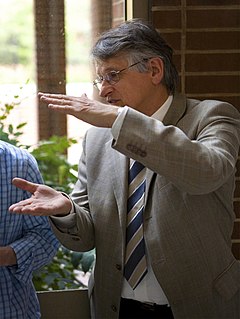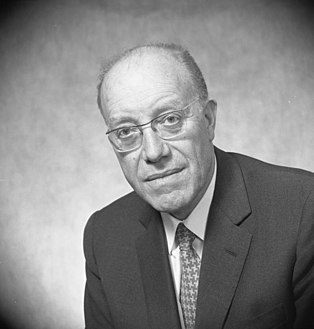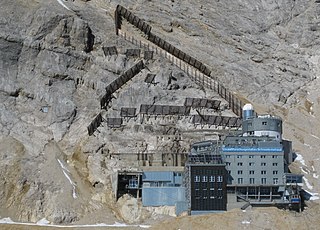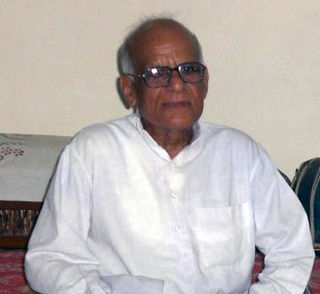
Nokia Bell Labs is an American industrial research and scientific development company owned by Finnish company Nokia. With headquarters located in Murray Hill, New Jersey, the company operates several laboratories in the United States and around the world. Bell Labs has its origins in the complex past of the Bell System.

Walter Hans Schottky was a German physicist who played a major early role in developing the theory of electron and ion emission phenomena, invented the screen-grid vacuum tube in 1915 while working at Siemens, co-invented the ribbon microphone and ribbon loudspeaker along with Dr. Erwin Gerlach in 1924 and later made many significant contributions in the areas of semiconductor devices, technical physics and technology.

The Technical University of Munich (TUM) is a public research university in Munich, with additional campuses in Garching, Freising, Heilbronn and Singapore. A technical university that specializes in engineering, technology, medicine, and the applied and natural sciences, it is organized into 15 schools and departments, and supported by numerous research centers.

A Schottky barrier, named after Walter H. Schottky, is a potential energy barrier for electrons formed at a metal–semiconductor junction. Schottky barriers have rectifying characteristics, suitable for use as a diode. One of the primary characteristics of a Schottky barrier is the Schottky barrier height, denoted by ΦB. The value of ΦB depends on the combination of metal and semiconductor.

Garching bei München or Garching is a town in Bavaria, Germany, near Munich. It is the home of several research institutes and university departments on its campus. It became a city on 14 September 1990.

Klaus von Klitzing is a German physicist, known for discovery of the integer quantum Hall effect, for which he was awarded the 1985 Nobel Prize in Physics.

The University of Regensburg is a public research university located in the medieval city of Regensburg, Bavaria, a city that is listed as a UNESCO World Heritage Site. The university was founded on July 18, 1962 by the Landtag of Bavaria as the fourth full-fledged university in Bavaria. Following groundbreaking in 1965, the university officially opened to students during the 1967–1968 winter semester, initially housing faculties in Law and Business Sciences and Philosophy. During the summer semester of 1968 the faculty of Theology was created. Currently, the University of Regensburg houses eleven faculties.
The acronym WSI may refer to:
The Gottfried Wilhelm Leibniz Prize, in short Leibniz Prize, is awarded by the German Research Foundation to "exceptional scientists and academics for their outstanding achievements in the field of research". Since 1986, up to ten prizes are awarded annually to individuals or research groups working at a research institution in Germany or at a German research institution abroad. It is considered the most important research award in Germany.

Ilse Aigner is a German politician and member of the Christian Social Union of Bavaria (CSU).
In solid-state physics, a metal–semiconductor (M–S) junction is a type of electrical junction in which a metal comes in close contact with a semiconductor material. It is the oldest practical semiconductor device. M–S junctions can either be rectifying or non-rectifying. The rectifying metal–semiconductor junction forms a Schottky barrier, making a device known as a Schottky diode, while the non-rectifying junction is called an ohmic contact.

Heinz Maier-Leibnitz was a German physicist. He made contributions to nuclear spectroscopy, coincidence measurement techniques, radioactive tracers for biochemistry and medicine, and neutron optics. He was an influential educator and an advisor to the Federal Republic of Germany on nuclear programs.

The Schneefernerhaus is a former hotel in the Alps, that is now used as an environmental research station. It lies immediately below the summit of the Zugspitze at a height of 2,650 m and was opened on 20 June 1931. It used to house the top station of the Bavarian Zugspitze Railway as well as a tourist hotel. There was then a cable car from the Schneefernerhaus to the Zugspitze summit. In 1938 a gallery for pedestrians was opened from the ridge station of the Tyrolean Zugspitze Cable Car to the Schneefernerhaus. From 1945 to 1952 the hotel was commandeered for use as a "recreation facility" by the US Forces.
Karl Heinz Beckurts was a German physicist and research manager.

Man Singh Tyagi, better known as M. S. Tyagi, is a retired professor of Electrical Engineering form Indian Institute of Technology Kanpur.

Dawon Kahng was a Korean-American electrical engineer and inventor, known for his work in solid-state electronics. He is best known for inventing the MOSFET, along with his colleague Mohamed Atalla, in 1959. Kahng and Atalla developed both the PMOS and NMOS processes for MOSFET semiconductor device fabrication. The MOSFET is the most widely used type of transistor, and the basic element in most modern electronic equipment.

Mohamed M. Atalla was an Egyptian-American engineer, physical chemist, cryptographer, inventor and entrepreneur. He was a semiconductor pioneer who made important contributions to modern electronics. He is best known for inventing the MOSFET in 1959, which along with Atalla's earlier surface passivation and thermal oxidation processes, revolutionized the electronics industry. He is also known as the founder of the data security company Atalla Corporation, founded in 1972. He received the Stuart Ballantine Medal and was inducted into the National Inventors Hall of Fame for his important contributions to semiconductor technology as well as data security.
Maria-Elisabeth Michel-Beyerle is a German chemist. From 1974-2000 she was a professor of Physical Chemistry at the Technical University of Munich. Among other awards, she has received the 2000 Bavarian Order of Merit, the highest service order bestowed by the Free State of Bavaria, for her work on photosynthesis.
Jonathan James Finley is a Professor of Physics at the Technical University of Munich in Garching, Germany, where he holds the Chair of Semiconductor Nanostructures and Quantum Systems. His focus is on quantum phenomena in semiconductor nanostructures, photonic materials, dielectric and metallic films, among others, for applications in quantum technology. At such, he made major contributions to the characterization and understanding of the optical, electronic and spintronic properties of quantum dots and wires both from group-IV and II-VI materials and oxides.

The Campus Garching is a campus of the Technical University of Munich and a number of other research institutes, located around 10 km north of Munich in Garching. At the same time, it constitutes a district of the city. With more than 7,500 employees and around 17,000 students, it is one of the largest centers for science, research and teaching in Germany.














